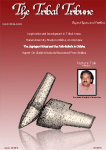Human Diversity Study in Odisha: An Overview
Abstract
Odisha has been a part of Indian civilization from prehistoric times. The geographical boundaries of the State of Odisha had never been fixed in history. Odisha is primarily referred to the coastal region, its culture and the dominant Odia language. Odisha as a state is a confluence of two major cultural streams of India. Tribal communities and caste societies constitute its socio-cultural universe and represent different stages in the scale of social evolution. Since colonial period, diversity studies in Odisha was characterised by the perception of Odia culture as a bounded entity, and was concerned with the description and classification of human societies on the basis of anthropometric, somatoscopic and serological information. In post-colonial context, the nature and trajectory of human science has undergone radical changes. The diverse information available about human past as well as the recent advances in knowledge has expanded the scope of human diversity study. Human genome project, being the turning point, data on differences between individuals and between species at molecular level not only form the basis for anthropological knowledge but also suggests important implications in forensic and medical genetics. Recent evidences from archaeology, genetics and linguistics provide a synthetic view on diversity of Odisha population. In this paper an overview of the diversities found in Odisha population on the basis of archeological, linguistic and genetic studies conducted so far by various authors has been presented.
1. Introduction
Humans are among the world’s most adaptable creatures. Anthropology studies the sum total of the human condition: past, present, and future. Anthropology deals with and considers major questions of human existence as it explores human biological and cultural diversity in time and space. Of particular interest is the diversity that comes through human adaptability. As human history has unfolded, the social and cultural means of adaptation have become increasingly important. In the process, humans have developed diverse ways of coping with the range of environments they have occupied in time and space. The rate of cultural adaptation and change has accelerated, particularly during the past 10,000 years. For millions of years, hunting and gathering of nature’s bounty—foraging—was the sole basis of human subsistence. However, it took only a few thousand years for food production through the cultivation of plants and domestication of animals, which originated some 12,000–10,000 years ago, to replace foraging in most areas. Between 6000 and 5000 BP. (before the present), the first civilizations arose. There has been tremendous interest among anthropologists and geneticists to understand the unique structure of Indian populations and their affinities with the rest of the world. India is well-known for its human and geographical diversities. There are various evidences supporting the peopling of India by the early modern humans. It is well established that the modern human originated in Africa about 200,000 years before present (YBP)[ Cavalli-Sforza, 1998; Yotova et al., 2007]. They started migrating out-of-Africa between 55,000 and 85,000 YBP. There are several opinions regarding the cause and timing of this migration. One compelling view being put forward is based on geological finding. It states that there was a mega drought in East Africa between 135,000 and 75,000 YBP, when the water volume of Lake Malawi was reduced by at least 95%[ Scholz et al., 2007]. The timing of this mega drought corresponds with the timing of the exodus of anatomically modern humans out-of-Africa along the southern coastal route [Macaulay et al., 2005; Thangaraj et al., 2005]. The establishment of the southern coastal route of modern human migration reveals India as a major corridor for early human migration. The anthropological, historical, linguistic and genetic evidences for early peopling of India are found imprinted all over the country. There are 4,635 anthropologically well-defined human populations; 532 are tribes, including 72 ancestral tribes with the hunter and gatherer lifestyle (Census, 2001). The size of these populations ranges from a few hundred to several millions. The total population count of India has reached 1.21 billion (Census, 2011). Recent genetic studies revealed the in situ origin of several deep-rooting mtDNA lineages in India, suggesting that Indian populations are genetically unique and harbour the second highest genetic diversity after Africans. Evidence of humanoid population in India may stretch as far back as 1,500,000 years before present. Modern humans settled in India in multiple waves of migrations, over tens of millennia. The first migrants came with the Southern Coastal dispersal, ca. 60,000 years ago, where after complex migrations within south and southeast Asia took place (Papu et al., 2011; Tamang et al., 2012). It has been also reported that India occupies the centre stage of Paleolithic and Neolithic migrations and, further the recent systematic analysis of genome-wide data, reveals five distinct ancestral components, contrary to two ancestries inferred earlier in India (Basu et al., 2016).
Geologically, 140 million years ago, Odisha, was a part of the Gondwana supercontinent. The oldest rocks, the Mayurbhanj granite pluton, that are found in Orissa are 3.09 billion years old, dating to back Precambrian times. (Mahalik, 2000). The coal-fields in Mahanadi and IB river basins are known to be one of the richest sites for fossils in the subcontinent. It has been also reported that the human history in Odisha begins in the Lower Paleolithic era, as Acheulian tools dating to the period have been discovered in various places in the region (Ghosh, 1990). Geographically, the boundary of the State of Odisha was never fixed. Because, in history, Odisha was known differently as Kalinga, Utkal, Odra, Tosali and Kosal, at different periods as well as in the ancient Sanskrit and Pali literature and hence, had different geographical boundaries. It is being suggested that these regions inhabited by different stocks of people, in course of time, got amalgamated. (Behura and Mohanty, 2006; Nayak, 2007). The people of Odisha are ethnically heterogeneous, and in their social, cultural and linguistic make up, they display enormous diversity. The diversities found in biological make up, social systems and cultural patterns, have made Odisha a unique state in India.
The State of Odisha is inhabited by a large number of castes and tribes, which, however, are not of one uniform mass but present a wide linguistic , ethnic and cultural varieties in various states of economic and cultural development-(Behura and Mohanty 2006). There are sixty-two scheduled tribes including thirteen Particularly Vulnerable Tribal Groups (PVTGs) and ninety scheduled castes, which respectively constitute 22.16% and 16.3% of the total state population.
2. Limitations of Human Diversity study
Anthropology’s comparative, biocultural perspective recognizes that environmental factors, including customary diet and other cultural forces, constantly mold human biology. Culture is a key environmental force in determining how human bodies grow and develop. Cultural traditions promote certain activities and abilities, discourage others, and set standards of physical well-being and attractiveness. Historically, scientists have approached the study of human biological diversity in two principal ways: (1) racial classification (now largely abandoned) and (2) the current explanatory approach, which focuses on understanding specific differences. The diversity study of any region has to rely on Lingusitic, Archeological and Biological records. In linguistic context it should be remembered that no language retains the evidence of its origin beyond past 6000 years. This is the suggestion that the historical linguists make after analyzing 6500 currently spoken languages. Another suggestion is that a common ancestry for all human languages cannot be identified. In archeological context, it is worth mentioning that the earliest recognizable stone tools are about 2.5 million years old. But from Palaeoanthropological records i.e. the earliest fossils that appear to be more closely related to humans than to any other living species are dated to be 5-7 million years ago. Biological context, where genome of living species and evolutionary process are made basis, takes one beyond, back to the last common ancestor of all extant species. (Jobling et al, 2004)
3. Linguistic Diversity in Odisha
Historical linguistics is doubtless a reflection of past population movements and interactions, as are genetics (Renfrew, 2000; Fuller, 2007). The process of language change and mixing is complex, as variants enter a pool in which selection takes place for a variety of social and cultural reasons (Mufwene, 2001).
The dominant spoken language of the Odishan people had never been Sanskrit, Prakrit or Pali, rather, a language derived from all of them. If the form and content of the Odia language is analysed in depth, it would probably bring out amazing results, the essence of which would reveal that the Odia language shares much in common with tribal languages of Odisha. (Behura and Mohanty , 2006; Nayak, 2007). The antiquity of Odia language and literature, on the basis of its literary heritage, has been recognized as it is recently (20th February 2014) accorded Classical language status by the Government of India. In fact Odia is the sixth Indian Classical language, preceding other five are Tamil, Sanskrit, Kannad, Telegu, Malayalee. (Panigrahi, 2014). Notwithstanding Odia, being the dominant language of the State, the languages spoken by inhabitants of Odisha are divided into three ethno-linguistic groups viz., Indo Aryan, Dravidian and Austro-Asiatic as mentioned below (Table 1 and Figuge-1& 2). It may be mentioned that after the Tibetan refugees were settled in Chandragiri, in Gajpati district of Odisha almost half a century ago (1963), the Tibeto-Burmese linguistic group can not be ignored from this classification (Satapathy, 2010).
Table 1: Linguistic Groups in Odisha
|
Linguistic Groups in Odisha |
Ethnic Speakers |
|
• Indo-Aryan: Oriya, Laria, Halbi |
Saunti, Matia, Jhodia Paroja, Bhuyan, Bathudi |
|
• Dravidian: Kui, Kuvi, Gondi, Kuurukh, Koya, Parji |
Kondh, Koya, Gond, Paraja, Oraon, Kisan |
|
• Ausrtro-Asiatic: Savar, Mundari, Santali, Juang |
Santal, Juang, Mahali, Kharia, Ho, Gadaba |

Figure 1: South Asian Language Families
(Source : http://en.wikipedia.org/wiki/Languages_of_India#mediaviewer/File:South_Asian_Language_Families.jpg retrieved on 05.03.2015)
3.1 Austro-asiatic linguistic groups in Odisha and its significance in diversity study.
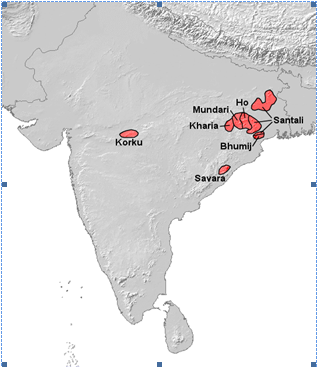
(Figure 2: Austro-asiatic linguistic groups(Munda speakers) in OdishaSource:http://en.wikipedia.org/wiki/Munda_languages#mediaviewer/File:Munda-Sprachen.png retrieved on 21.03.2014)
Austroasiatic is the eighth largest language family in the world in terms of the number of native speakers (104 million) (Lewis, 2009). It has been suggested that the communities affiliated to the Austro-Asiatic linguistic family are perhaps the first to settle in India and the palaeoanthropological evidences suggest the earliest settlement probably around 60,000 years BP. Recent speculations, based on both traditional genetic markers and DNA markers, seem to corroborate the aforesaid view (Kumar and Reddy., 2003). But the tribal communities belonging to different linguistic families can be classified on certain other characteristics to suggest diversity at other levels. The geographic origin and time of dispersal of Austroasiatic (AA) speakers, presently settled in south and southeast Asia, remains disputed. Two rival hypotheses, both assuming a demic component to the language dispersal, have been proposed. The first of these places the origin of Austroasiatic speakers in southeast Asia with a later dispersal to south Asia during the Neolithic period, whereas the second hypothesis advocates pre-Neolithic origins and dispersal of this language family from south Asia. To test the two alternative models, this study combines the analysis of uniparentally-inherited markers with 610,000 common single nucleotide polymorphism loci from the nuclear genome. Indian AA speakers have high frequencies of Y chromosome haplogroup O2a; our results show that this haplogroup has significantly higher diversity and coalescent time (17–28 thousand years ago) in southeast Asia, strongly supporting the first of the two hypotheses. Nevertheless, the results of principal component and “structure-like” analyses on autosomal loci also show that the population history of AA speakers in India is more complex, being characterized by two ancestral components—one represented in the pattern of Y chromosomal and EDAR results and the other by mitochondrial DNA diversity and genomic structure. We propose that AA speakers in India today are derived from dispersal from southeast Asia, followed by extensive sex-specific admixture with local Indian populations (Chaubey et al., 2011).
3.2 Evidence of Early Human Habitation, Domestication of Rice in Jeypore tract of Odisha
Domestication of rice started earlier to 3000 B.C. and possibly at a number of centers in South and South-east Asia. Jeypore tract in South Odisha has been established as the centre of origin of rice (Oriza sativa) by (Sharma et al, 2000). There are 1,745 germplasm accessions of cultivated rice and 150 accessions of wild rice from Jeypore tract of Odisha collected by Botanical Society and Central Rice Research Institute between 1955-59 (Govindaswami and Krishnamurty, 1959; Mishra, 2009).
Soura and Gadaba are the first rice cultivators, according to evidences from the Carbon-14 (C 14) dating of fossil grains and other evidences (Lenka, 2001). The Soura made terraces in the valleys and hills for rice cultivation extending up the hill slopes in most cases and in some, up to the hilltop, with 10ft (3.3meter) heigh boulder walls. Soura hills might be the original home of rice .The Gadaba follow the myda system of rice cultivation in which two varieties of rice are grown together in the plateau regions (Mishra, 2009). The Bondo are living in Jeypore tract and are expert and skilled cultivators who practice shifting cultivation quite extensively. It is believed that Souras, Gadabas and Bondos improved the rice cultivation of wild rice gradually. The tribes of Koraput belong to the Munda ethno-linguistic group. The specific term for rice or related to rice is limited in this language. Anthropologically, the whole area, from the western coast of India to the eastern coast of South China and Vietnam, was inhabited in the pre-historic period by the Proto-Austroloid people. The language spoken by these people has two main divisions namely, Munda or Koi and Mon-Khmer. The Munda group of language is spoken in India by the tribal of Bihar and Odisha, and the Mon-Khmer groups of languages by the people of southern Burma (Myanmar) and Cambodia . It is, therefore, probable that the people associated with the domestication of rice were Proto-Austaloids (Hamada, 1949) [Figure-3]. Odisha is important area in terms of development of early agriculture in India as a whole. A number of crops have originated in this region including rice, pigeon pea, urad and mug bean, several grounds, and root crops such as taro and yam. Hypothesized that two quite different neolithic traditions, one associated with the coastal plain and major river valley and another with the foothills and upland, the tribal areas, and this Eastern Wetland tradition began in the early third millenium B.C. and continued into the Iron Age (early first Millennium B. C.), as at Golbai Sasan, Gopalpur and probably also Khameswaripalli (Behera, 2002)[Harvey et al 2006].

(Figure 3: Source: Smita Mishra, Farming System in Jeyopur Track of Orissa, India, 2009)
4. Cultural Variation
It is said that centuries co-exist in India because of her cultural variation. It is more so in Odisha. Many cultural currents have flowed into a confluence; especially they have come from the north and South. Odisha is a great stage with a large cast of characters portraying many cultural prototypes. In Sri Jagannath culture there is a fusion of celebration of Aryan and non-Aryan worshipping without any conflict. Tradition and practices followed in the Jagannath temple indicate that Lord Jagannath is of tribal origin ( Kulke and Schnepel, 2001;Mohapatra, 2007).
4.1 Settlement Pattern: All Munda speaking tribes have scattered settlement structures. However, each Munda speaking tribe maintains its own structural arrangement.
The Kondh (Dravidian) settlement structure is linear, arranged in rows of houses. The alignment and orientation of any Kondh village in relation to the shrine of earth goddess and sun god is same everywhere. Tribes like Bonda, Dongria Kondh, Juang, Gadaba, Koya, Lanjia Saora, Santal etc exhibit their distinctiveness in their clothing, adornment, art and hair style.
4.2 Social Variation:
Majority of tribes in Odisha are divided into exogamous clans having totemic symbols as well as non-totemic symbols. Saora (Austro Asiatic) is one tribe, which is reported to have no clan system but a system of descent groups known as Birinda. Bondo (Austro Asiatic) tribe is having a dual social organization (moiety). Koya tribe has more than two social divisions termed as phratries, and each one of phartries in turn divided into several exogeneous clans. The Dongria Kondhs are divided into more than thirty clans, some are totemic and others are not. Munda tribe has 350 clans. Similarly the tribes of Odisha is also categorized into three categories on the basis of socio-cultural levels such as
1. Particularly Vulnerable Tribal Groups: Birhor, Bonda, Chuktia Bhunjia, Didayi, Dongria Kondh, Hill Kharia, Juang, Kutia Kondh, Lanjia Saora, Lodha, Mankirdia, Paudi Bhuyan, Saora, 2. Tribes in Transition: Santal, Kharia, Oraon, Kissan, and 3. Assimilated Tribes: Savar, Gond, Bathudi, Bhuyan, Saunti (SCSTRTI, 2010)
4.3 Techno-Economic Categories of STs of Odisha:
Shifting cultivation is an age-old practice, particularly being practised in the Eastern Ghats. Orissa accounts for the largest area under shifting cultivation in India. The tribal communities, viz. Kondha, KutiaKondha, DongriaKondha, LanjiaSauras, Paraja, Godaba, Koya, Didayi, Bonda, Juang and Pauri Bhuyan, Peranga and Erenga Kolha are involved in this practice. Shifting cultivation persists in hill regions, which are more marginal for sedentary, high intensity agriculture and state procurement of taxation. This can be considered as a strategy both to exploit more marginal lands and to avoid state domination. The origins of this historical equilibrium are hypothesized to be contemporary with the expansion of later Neolithic agriculture (4000- 3000 BP) and the development of hierarchical polities in the Indian plains during the Iron Age (mainly after 3000 BP). The archaeological record of early agriculture indicates that cultivation precedes sedentary villages, suggesting that shifting cultivation may have been a widespread economic system in the Neolithic, in both the Ganges Valley and the Deccan Plateau of South India. These areas are more suited to sedentary cultivation that could support higher population densities. Therefore, as populations grew in the Neolithic period, the economic system shifted to sedentary agriculture. The expansion of trade networks, hierarchical societies and demographic density pushed shifting cultivation practices into increasingly marginal settings, where this became an interdependent strategy. Specialist hunter gatherers trading in forest products became an increasingly important aspect of forest exploitation as did cultivation of ‘cash crop trees’ (Kingwell-Banham et al 2011). The tribes in Odisha are categorized on the basis of techno-economic categories as follows (Table2, SCSTRTI, 2010).
Table 2: Distribution of tribes of Odisha on the basis of techno-economic level
|
Hunter-Gatherer |
Birhor, Hill Kharia, Mankirdia |
|
Pastoral |
Koya, Gadaba |
|
Shifting Cultivators |
Bonda, Bhuyan, Didayi, Juang, Kondh, Paroja, Saroa |
|
Settled Cultivators |
Santal, Oraon, Bhottado, Ho, Munda, Gond |
|
Industrial Worker |
Oraon, Munda |
Source: population profile of tribes of Odisha, SCSTRTI, 2010
5. Evidence from Odisha Prehistory
The history of India begins with evidence of human activity of Anatomically modern humans, about 75,000 years ago, or with earlier hominids including Homo erectus about 500,000 years ago .The presence of intelligent hominins in the subcontinent may stretch as far back as 1.51 ± 0.07 million years ago to the Acheulean period (Papu et al., 2011). Acheulian tools are the product of a distinctive set of tool-making techniques that originated in Africa and then spread to Europe and Asia. The few dates available for Indian Acheulian sites were obtained years ago through a method that measures isotopes of thorium and uranium (230Th/234U), and there are good reasons to suspect that it seriously underestimated their true ages (Dennell, 2011).
In Odisha too, the recovery of paleo cultural relics have helped to study the processual development of cultural phases from the initial lithic cultural phase to the metal age culture. In 1876 Valentine Ball first brought the paleolithic artifacts from Anugul, Talcher, Dhenkanal and Bursapalli; Paramananda Acharya (1923-24) reported neolithic artefacts from Baidpur, Mayurbhanj, north Odisha; R. D. Banerji (1930) first incorporated prehistoric studies in Odisha as part of History of Odisha.;E. C. Worman and P Acharya (1939)- reported about paleolithic sites in Kuliana, Mayurbhanj. N. K. Bose and D. Sen (1939-42)- excavated subsequently at Kuliana in Mayurbhanj. D. Sen, G. S. Ray and A. Beteille (1948) found two laterite querries at Bangiriposhi , situated at river Budhabalang. A. Choudhury 1956- reported bovid tooth in the fossil collection from Mukramatia. Various further studies do show the paleocultural phases from the initial lithic cultural phase to the metal age such as G. C. Mohapatra, 1957-59; K. C. Tripathy, 1969-72; S C Nanda, 1983;, P K Singh, 1985;, S. B. Ota, 1986; R. N. Das, 1987; P. K. Behera, 1989;, P. Yule, B. K. Rath and K. Hojgaard, 1990;, K. K. Basa, 1987,2000, 2014; D Sahoo, 2010[Basa and Sahoo, 2015]. However, the evidences of
human remains studied by Karen Hojgarrd (2000), that is the dental anthropology of Sankerjang, Anugul, Odisha; by P. K. Das and S. K. Ghoushmaulik (2000) analysing the skeletial remains of Golobai, Khurdha,Odisha; by Walimbe and Tripathy (2013 and 2014) on the human remains of one adult male, one adult female and that of perinatal child at Bang, Harirajpur, Khurdha, Odisha suggest the emergence of early farming community in Odisha[Tripathy, 1982; Basa and Sahoo, 2015].
5.1 Lower Paleolithic in Odisha
The main lower palaeolithic tool types of northern Odisha are hand axe, cleaver, scraper, crude points, flakes and cores. Flaked pebbles form an integral part of the bifacial hand axe- cleaver tradition. There is presence of Levalloisian and Proto- Levalloisian elements. Quartzite is the main raw material. The industry is mainly a part of the peninsular hand axe- cleaver tradition. But the earliest stage of lithic industries of south- western Orissa in the Tel basin is represented by pebble industry. The choppers exhibit crude manufacture whereas the scrapers, points and miniature hand axes show moderate skill of tool manufacture. The presence of small scrapers and points suggest the appearance of new types. However, the pebble tools and flakes appear to be an integral part of the industry [Tripathy, 1982; Basa and Sahoo, 2015; Sahoo, 2015a].
5.2 Middle Paleolithic Sites in Odisha
The middle palaeolithic is usually associated with the concentration of flake tools. Stratigraphically it is found to be preceding the non-geometric microliths of mesolithic period and following the lower palaeolithic age. The tool types include scraper, point, burin, and scraper-cum–borer. Besides, the industry is associated with flakes, cores, nodules and blades and blade-like flakes. The tools are of smaller dimension than those of the lower palaeolithic and are usually made of fine-grained raw materials. In comparison to northern Orissa, the distribution is sparse, yet there has been profuse occurrence of middle palaeolithic artifacts at certain localities.
5.3 Upper Paleolithic Sites in Odisha
With regard to the upper palaeolithic, while S.K. Mishra in 1983 discussed the upper palaeolithic problems of Odisha, it was S.C. Nanda in 1982-83 and 1984 who reported upper palaeolithic industry as a distinct typological entity in the Indravati basin. Nanda divided the upper palaeolithic industry into two groups: (a) shaped artifacts comprising scrapers, denticulates, notches, knives, burins, backed blades and (b) simple artifacts including cores, flakes, blades, chips and worked nodules. The shaped artifacts show deliberate retouching on one or more edges while the simple artifacts are the intermediary and byproducts of the shaped tools. Excavation at Girla on the Indravati valley by S.C. Nanda revealed a stratified horizon of the upper palaeolithic occupation, which was succeeded by the Mesolithic industry. Upper palaeolithic artifacts were reported by P. K. Behera from the Brahmani valley in Sundargarh, by K.K. Basa and S.K. Mishra from Baripada, Rairangpur, Karanjia regions of Mayurbhanj, and by A. K. Ghosh and Subha Ray from Utkal University Campus, Bhubaneswar.
5.4 Mesolithic in Odisha
The distribution of Mesolithic culture - is fairly widespread in Odisha with microliths being available in abundance mainly in non-geometric from, though geometric microliths are not completely absent. The tool types include parallel-sided blades, fluted cores, scrapers, flakes, obliquely retouched blades, burins and points etc. The association of heavy-duty tools as a typical feature of Odishan mesolithic culture as shown by S. B. Ota and P. Mohanty of Decan College was also established by the team led by K. K. Basa and D. Sahoo of Utkal University during the area study of Duburi-Tamaka. .
5.5 Neolithic Sites in Odisha
The typical neolithic tools like shouldered celts (Figure-4), ring stones etc. are available from a number of sites, from Bolangir and Sambalpur districts, from Khordha in erstwhile Puri district, from Sankerjang in Dhenkanal district and Darpankhash in Jajpur district (Sahoo and Tripathy, 1989). The exploration undertaken by the department of Anthropology, Utkal University, Bhubaneswar, Odisha, in the year 1978, led to the discovery of neolithic implements at Banarpal and Angul in Dhenkanal district, and in 1982 from Sundergarh district. The tools discovered are from the surface.
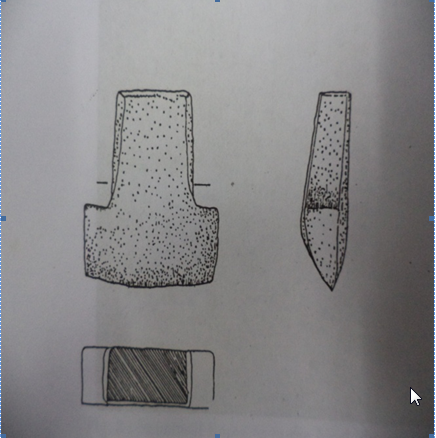
Figure 4: Shouldered Celts, Source: Archaeology of Orissa by Basa et al 2000
5.6 Chalocolithic Age in Odisha
Surveys in the Kerjang area of Angul district during 1999, 2000 and 2001 resulted in the discovery of Neolithic, chalcolithic and Iron Age sites in addition to palaeolithic and Mesolithic sites. In 2003 the surface exploration around Kardi area in the middle Mahanadi valley of Boudh district in the central part of Odisha yielded huge amount of microliths and a few neoliths and a site revealing the occurrence of volcanic ash-a deposit of YTT (Youngest Toba Tephra) on the right bank of the Mahanadi at Krushnamohanpur near Kardi. An early historic site was also located at Kardi.Similarly, the excavation of Chalcolithic site at Sankerjang, Angul, Odisha by P. Yule and B. K. Rath (1989) yielded unique polished stone bars (lithophones) considered as some kind of musical instrument and also this site was credited for first radio carbon date in Odisha. However, the human dental remains (41 teeth) recovered from the site, Karen Hojgaard infers that there is evidence for at least 5 children and 4 adults and that Sankerjang inhabitants consumed food rich in carbohydrates, i.e rice, grain or peas. B. K. Sinha (2000) excavated
Golobai near Khurdha, Odisha shows the Neolithic – Chalcolithic culture tradition . P. K. Das and S. K. Ghoshmaulik (2000) analysis of skeletal material analysis revealed that it belongs to the young individual with out skull with plenty of potsherds and other materials. The skeleton is of a female of very tender age and was beheaded before burial. The excavations made in 2013 and 2014 at Bang Harirajpur by K K Basa et al reveals Neolithic Chalcolithic culture tradition along with the human skeleton of an adult males, infant and of a women. Feet of the dead person were chopped off before the body was placed in the pit and the dental samples DNA analysis in collaboration with CCMB, Hyderabad reveals that haplogroup M2 type which is yet to be published (personal communication with Basa, 2014). Haplogroup M2 found in South Asia, with highest concentrations in South East India and Bangladesh; oldest haplogroup M lineage on the Indian sub-continent(Figure-5). Also found with low frequency in southwestern China.( Sahoo and Kashyap, 2005; , Chandrasekhar A et al 2009).
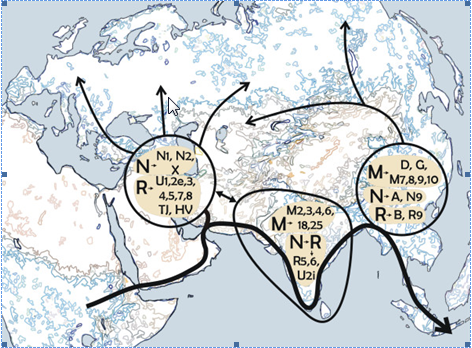
Figure 5: Human Mitochondrial Haplogroup M Source: https://en.wikipedia.org/wiki/Haplogroup_M_(mtDNA)
There are two types of interesting discoveries from Bang-Harirajpur excavation. The first includes remains of a habitational floor with 18 postholes implying a circular hut. The second includes the recovery of three skeletal remains – one adult male, an adult female and that of a perinatal child.
This is for the first time that three human skeletons have been unearthed from an archaeological site in Odisha.
The skeletons have been studied by Prof. S. Walimbe and Dr. Veena Mushrif-Tripathy from Deccan College. While the male is believed to have an estimated stature of 5’7” and died at the age of around 35-40 years, the child is very young and died around birth time. The female skeleton is an adult of about 5 feet in stature estimation with slender body built and died at the age around 30-35 years. Needless to say the site of Harirajpur has generated a lot of interest among archaeologists, local people and heritage lovers of the State. One could say that when studied in details, the excavations at Bang-Harirajpur would provide an example in respect of the emergence of early farming community in Coastal Odisha (Basa and Sahoo, 2015). “There is, however, a significant evidence of healed fracture of left forearm. The left side ulna and radius exhibit oblique fracture resulting from an indirect trauma. This incidence took place during the adult phase of the individual (around 25 years of age), and the fractured bones were, however, found to have been completely healed .
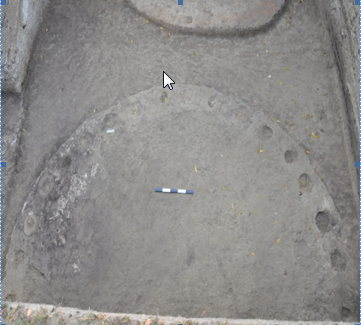
Figure 6 (a): Habitational floor with 18 post holes implying a circular hut and

(b)
Figure 6 (b): Stone tools Basa et al 2013&2014)
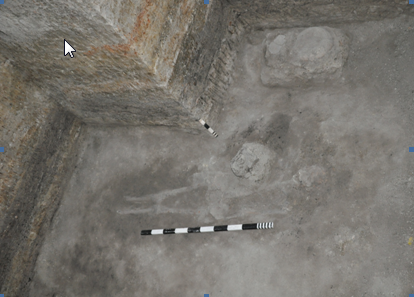
(a)
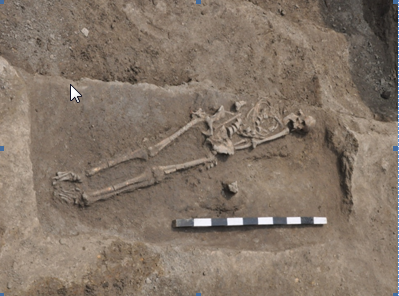
(b)
Figure 7: Recovery of three skeletal remains – one adult male (a), an adult female (b) and that of a perinatal child, Basa and Sahoo, 2015
The Bang-Harirajpur excavation shows resemblance with that of Deccan Chalcolithic whose absolute Time Period is c. 5000-3100B.P.Similarly, the material culture as well as the skeletal remains exhibits contemporary of the Jorwe Culture which was dated c.3500-3000B.P;
Inamgaon (c.3600-2700B.P). Adults were buried in an extended posture in an oval pit with the head towards the north and the legs towards the south. Usually the feet of the dead person were chopped off before the body was placed in the pit. The dead body was usually accompanied by a spouted vessel and concave carinated bowl, and sometimes blade tools and ornaments like beads and bangles. The excavation also yielded a number of terracotta male and female human figurine, which may have been meant for worship(Peregrine and Ember , 2002)

(a)

(b)
Figure 8 (a): Feet of the dead person were chopped off before the body was placed in the pit (b) the fractured Ulna bones were completely healed, Bang-Harirajpur, Odisha, Basa and Sahoo, 2015
5.7 Rock Arts in Odisha
The rock-art heritage of Odisha range from the prehistoric Mesolithic period to the Early Iron Age through, of course, the Neolithic Chalcolithic period (Pradhan, 2009). Paintings are mostly found in minimal dark red, purple red, white, yellow, blue and black. Paintings appear as jumble of indefinite and enigmatic geometric and ageometric patterns and forms. There is a complete absence of hunting and chasing scene in Odisahn rock art. Depiction of man and animal is very common. Plants are less frequent (Dash, 2015). It has been reported that there are a total of 6778 rock arts in Odisha out of which, rock art paintings are 2425 (35.78%), and engravings constitute 4353 (64.22%). There are 106 rock art shelters, while 49 (46.22%) shelters document engravings, 18 (16.98%) shelters report engravings along with paintings and 39 (36.80%) shelters are exclusively with paintings distributed in eleven districts.
The state of Orissa found its place in the rock art map of India in 1933 when K. P. Jayaswal (1933) reported one of the earliest evidences of rock engravings in India from the rock shelter of Vikramkhol in the present district of Jharsuguda (erstwhile Sambalpur district). Thereafter several scholars have enriched the literature on rock art either through their interpretations or by exploring new rock art sites Chakravarti, 1936; Fabri, 1960; Pradhan, 2015). The ethno-archaeological perspective drawn from Saura art reveals that the cult and myth can move a primitive community (Sauras) to some sort of artistic expression and such ethnographic information can be used in the interpretation of primeval rock art (Pradhan, 2009). Similarly, Gudahandi rock paintings of Kalahandi of Upper Paleolithic dated 20000BCE(Sajnani, 2001) [Figure 9a, b and c].
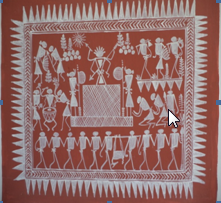
Figure 9(a) Soura Art
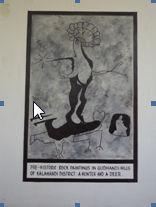
Figure 9(b) Gudahandi Art
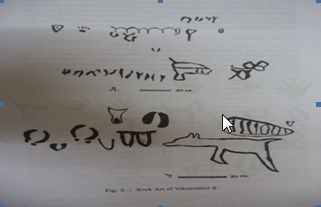
Figure 9(c) Rock art of Vikramkhol B depicts the origin of scripts (Jayaswal, KP, 1933)
Source : Archaeology of Odisha,( ed.) Basa et al, 2000),)
Similarly, the recent archaeological investigations made in and around the delta head of the Mahanadi reveal that there are two natural rock shelters having the evidences of typical rock art in the form of petroglyphs belong to Neolithic period (Sahoo, 2015b; 2016)
6. Nutritional diversity
The consumption of diet of the tribes in Odisha is extremely simple but a mixed one.
The dietary habits of tribal communities of Odisha are very much linked to several factors: ecological, socio-economic, socio-cultural and socio-psychological factors. Each tribe is distinguishable from the other on the basis of its unique food culture.
Nutritional diversity studies among the Saura, the Bonda, the Juang and the Koya reveal that having been nutritionally underfed they carryout their activities in all kinds of circumstances straining their body physiology. This trend undoubtedly poses question about the fundamental premise of balance nutrition that what should be considered as optimum calorie or protein requirement norm of an individual, belong which a man may be called semi starved or fully starved (Das and Mohanty, 2007). Consumption of milk and milk product is very low (SCSTRI, 2010). Use of oil is less; consumption of sugar is also very low (SCSTRI, 2010).
Alcoholic drinks are very common: Mohua, Handia and Salap are the traditional drinks.
7. Physical diversity
Two major racial elements, as per B. S. Guha’s classification (1935), Proto-Australoid type with long head and rather broad nose not only constitute the oldest racial group, but also comprises perhaps the majority of the population of Odisha particularly among the Scheduled tribe and Schedules castes. The second major type, Western-brachycephales, with broad head and narrow nose are more widely found among the higher castes.
It is also observed that the tribes of northern Odisha are slightly taller than those of the tribes of southern Odisha, and even the Brahamans of north are taller than those of south Odisha. People can be remarkably differentiated by the shape of their nose and face. Tribes of Odisha are shorter in stature, have platyrrhine nose, broad faces (having high cheek bone). Upper caste people are taller and possess more leptorrihine nose (Deka2000).
The first report on anthropometry of some caste populations of Odisha was reported by Risley (1891). Contribution of other scholars on anthropometric study in Odisha include those of Guha (1935), Eicksted (1939), Basu(1929), Roy(1935), Roy (1949), Ray (1958) and Raychaudhury(1952), Deka & Rath(1976), Nayak,G(1985), Bharati(1999), Kshyatrya(1999), Ghoushmaulik(1978), Patel(1971), Das(1983), Modak(1996), Nanda(1993) et al[Satapathy and Patra, 2015].Irawati Karve’s (1954) anthropometric study on 28 castes and tribes of Odisha was considered to be the most comprehensive study on castes and tribes of Odisha[Deka 1982, Satapathy and Patra, 2015]. Two hypotheses emerge namely,
Hypothesis-I: Early inhabitants of Odisha were off shoot of pre-Dravidian stock and their progenies are still traceable in the forest tractsof the interior hilly regions , and
Hypothesis-II: There was a wave of migration of Austro-asiatic people. Mingling of the offshoots of the early migrants with the local inhabitants has caused diversity of physical characteristics in the population of Odisha (Deka, 1980).
8. Diversity in Genetic Markers
Major tribes of Odisha show heterogeneity and diversity with respect to various genetic markers. This may be due to continuous pressure of gene diffusion from different waves of people penetrating their territory and habitats in Odisha in course of invasions and migrations from the North-Western (Indo-Aryan) and North-Eastern (Mongoloid) parts of India during historical and ancient times. In addition to inter-tribal admixture, and sometimes intra-tribal isolation have also occurred as reflected by the genetic parameters studied here. There is a strong evidence (Balgir et al., 2004).for the operation of a compensatory selective mechanism against malaria by way of high prevalence of the sickle cell(HbS), betathalassemia and G-6-PD deficiency among different major tribes of Orissa.
The frequency of blood group B show its preponderance over blood group A among Bathudi, Bhuyan, Kissan, Kolha, Kondh, Munda, Oraon, Paraja, Santal and Saora tribes. In Bhumiz, Gond, Kharia and Lodha tribes the opposite is true, thereby suggesting their ethnic diversity ( Balgir et al., 2004 ). The frequency of Rhesus-negative phenotype is very low (range zero to 2.1%) among all the tribes of Odisha, and among Bhumiz, Kharia, Kissan, Kolha, Lodha, Munda, Paraja, Santal and Saora tribes it is completely absent. In the ABO blood groups system, the most commonly observed allele was O, followed by B and A, while in the Rhesus (D) system, allele d varied from zero to 14.5% among the major tribes of Odisha (Papiha et al., 1988; Das et al., 1996; Balgir, 2000). The incidence of Bombay phenotype as reported (Balgir, 2007) is 1 in 33 among the Kutia Kondh tribe, 1 in 127 among Kondh tribe, three cases in Bhuyan tribe and 1 in 1,244 among the tribal populations of Odisha. .
The practice of tribal and territorial endogamy in a smaller effective populations (for example, there are only 3,521 individuals in Paudi Bhuyan) results in smaller marital distance and inbreeding, leading to increased homozygous expression of rare recessive genetic characters like the Bombay (Oh) phenotype. This study further testifies that the incidence is higher in those states of India where the consanguinity is a common practice.
The study shows genetic heterogeneity and diversity with respect to above immuno-hematological genetic markers, and indicated not only the inter-tribal admixture but also diffusion with other racial groups of India (Balgir, 2006).
However, P.K.Das, in 1984 was first to show the genetic segregation and the relative divergence of the communities on the basis of language.
Sahoo and Kashyap (2005) revealed that the extent of genetic differentiation in the contemporary caste and tribal groups of Odisha is highly significant and constitutes two distinct genetic clusters. In the phylogenetic tree, the Odisha Brahmins showed close affinity to populations of North India, while Khandayat and Gope clustered with the tribal groups, suggesting a possibility of their origin from indigenous people. Another
study on coastal Odisha population reveal that geographic segregation has led to genetic divergence among population of similar ethnicity while population inhabiting same geographical region had higher genetic affinity despite their ethnic origin (Kapoor and Verma 2013). ABO locus among all showed maximum genetic divergence between the populations. The prevalence of abnormal hemoglobin HbE is reported in various distinct groups in Odisha, particularly the presence of HbE and the austroasiatic group of languages is significant.
9. Molecular Evidences
The HLA diversity (HLA- A, -B, and -DRB1 loci) of an Austroasiatic Munda population from Northeast India and its relationships with other populations from India and Southeast Asia reveals that the Munda from Northeast India exhibit a peculiar genetic profile with a reduced level of HLA diversity compared to surround-ing Indian populations. They also exhibit less diversity than Southeast Asian populations except at locus DRB 1. Several analyses using genetic distances indicate that the Mundas are much more closely related to populations from the Indian subcontinent than to Southeast Asian populations speaking languages of the same Austroasiatic linguistic family. On the other hand, they do not share a closer relationship with Dravidians compared with Indo-Europeans, which goes against the perception that the Mundas share a common and ancient Indian origin with Dravidians. However, this results do not favor either scenario, where the Munda would be representative of an ancestor (Riccio et al., 2011) (Figure-10)

[Figure 10 Geographical distribution of the two linguistic subfamilies (Munda, striped zones; Mon- khmer: grey zones, further divided into Khasi-Khmuic and Mon-Khmer subfamilies according to Diffloth, 2005) proposed for the Austro-Asiatic phylum. The block arrows illustrate schematically the two main hypotheses on the Austro-Asiatic origin: (Io) Indian origin with later dispersal to Southeast Asia (west to east grey arrow); (2°) Chinese origin with posterior dispersal southward to Southeast Asia, and then westward to India (east to west black arrow) ; Riccio et al.,2011]
9.1 Distribution of Y haplogroup O2a
Many scholars such as have studied a possible link between the distribution of Austroasiatic language communities and the M95 mutation, i.e. Y chromosomal haplogroup O2a . (, Kivisild et al., 2003;, Cordaux et al., 2004b). Frequency gradients for Y haplogroup O2a are mapped for the Indian Subcontinent and Southeast Asia by Sahoo etal. (2006) and are shown here intheDiagram ((Figure-11). At the same time, maternal lineages of Munda groups appear to be old and indigenous to the Subcontinent, as indeed can be said of many Indian mitochondrial lineages (Kivisild et al.,1999a, 1999b, 2003). So, themitochondrial picture indicates that the Munda maternal lineage derives from the earliest human settlers on the Subcontinent, whilst the predominant Y chromosome haplogroup favours a Southeast Asian paternal homeland for Austroasiatic language communities in India. In this context, Sahoo et al. (2006) rightly caution ‘against simplistic interpretations of either linguistic or genetic correlations’ (Driem,2007)
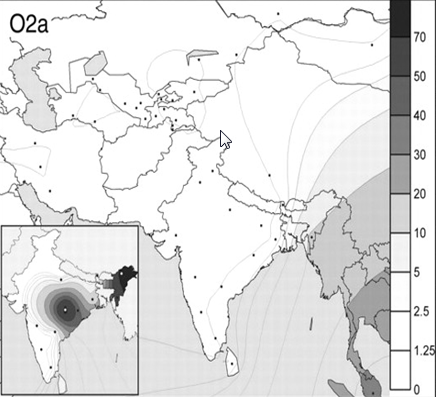
Figure 11 Spatial frequency distribution of Y haplogroup O2a for caste populations [big map] and tribal populations [inset map], reproduced here from Sahoo et al. (2006: 846).
Similarly, a study reveals a late Neolithic east to west expansion of Y Chromosomal haplogroup O2a-M95 from Laos (Arunkumar et al, 2015). An analysis of 15 microsetellite markers in Indian population which includes Odiya Brahamin, Khandyat, Karan, Gope of Odisha reveals that intrapopulation diversity is not only present at the national level, but also within smaller geographical region of the country (Kashyap et al., 2004).
Another study on 9 Y-STR loci shows highly polymorphism among Khandayat community (91) of Odisha which constituting 35% of the State’s population and are ancient worriers known as Kshatriya (Nayak et al, 2013).
Further it is observed that the Indian origin of paternal haplogroup R1a1* substantiates the autochthonous origin of Brahmins and the caste population and a tribal link to Indian Brahmins (Sharma et al., 2009). Since we observe high degree haplogroup diversity among tribal groups, it would be prudent on our part to consider ‘tribe’ as geometrically heterogeneous (Das, 2009).
10. Socio-ethical implications of Diversity Study
It has been kept in view that “history is rife with the misuse of anthropological research to justify regimes that have cost the lives and livelihoods of many innocent people. So much damage has been caused that some have even questioned whether work to reconstruct our evolutionary past should be undertaken at all. We believe that the potential intellectual and medical benefits of this work outweigh the potential dangers, but only when researches take responsibility for the accurate popularization and public dissemination of the research, including active opposition to misinterpretation.” (Jobling et al., 2004). Therefore, the biggest challenge, for anthropologists, to pursue research on human diversity in Odisha, lies not only at the methodological and operational level but also at moral level. The misuse of knowledge in recent time draws attentions of public as well as of intellectuals, which leads to controversies as well as breach of public trust. Be it the Bonda highlanders as Human Safari (Ref Survival International, Wikipedia, retrieved on 28th June 20132012), Rebati as Banabalika in 2008 (‘Bana Balika’ by Ramakanta Mahananda, The Samaj(Ravibar), June01-07, 2008), Kui dialect controversy and Social unrest in Kandhamal in 2007(The Hindu - October 15, 2007), Mango Kernel eating, traditional diet of tribals' of Kashipur Block of Odisha's Rayagada district..(The Hindu, September 9, 2001), Anthrax among Kutia Kandh (The New Indian Express, 14th June 2011), theseissuescan be honestly interpreted and misuse of knowledge can be avoided by addressing the dynamics of bio-cultural diversity prevailing in the respective areas.
11. Relevance of Diversity Study
The outcomes of diversity study in Odisha have yielded successful implementation of m
ultilingual education (MTL) in Tribal areas, identification of alcoholic protective gene among Bonda highlanders in 2010, possible M2 Haplogroup in archaeological excavation in Bang-Harirajpur during 2013 and 2014, location of Tuberculosis gene in the caste population of Odisha , and the Leprosy and social stigma among Payuri Bhuyan, (Das, 2009 and Satapathy and Patra, 2015). Studies on Hill-Bonda tribal population reveals that though this population is now isolated and endogamous in nature, still genetically they are not homogeneous in nature and exhibits ADH variant; hill-Bonda population are close to the Gond and the Sahariya population, whereas ALDH2*2 variant wise they are close to mongoloid groups (Nayak and Dash, 2015). Similary, recent studies made by Kshatriya and Acharya (2016) on Santals, Bhumijs, and Bathudis communities of Odisha reveals emerging triple burden of obesity, undernutrition and cardiovascular disease risk.
12. Conclusion
The bio-cultural diversity study of people of Odisha is still in its infancy. Whether the earlier inhabitants are still continuing is very difficult to say at this moment. Recent archaeological excavations, linguistic evidences as well as the findings on human molecular genetics givenew insight about the Neolithic Chalcolitic cultural tradition as well as possible early urbanization in coastal Odisha, occupation of the land as well as different waves of migration. Evidence from various sources such as the presence of Austro Asiatic linguistic groups with Neolithic shouldered axe, the practice of shifting cultivation, identification the possible early domestication of rice, abnormal haemoglobinopathies (HbS, HbE , betathalassemia and G6PD) as well as recent evidence of M2 haplogroups among the people of Odisha particularly the diversity observed in the Mayubhanj basin and Jayapur track constitute treasure trove for anthropology.
Acknowledgement
I express my deep sense of gratitude to Professor Kishor K Basa of P. G. Department of Anthropology, Utkal University as well as Professor Late P. K. Das, Head, Department of Anthropology, Guru Ghashi Das Central University, Bilashpur for their valuable suggestion and encouragement throughout preparation of this manuscript.
References
- Arunkumar, G. P., Wei, L., Kavitha, V. J., Syama, A., Arun,V. S., Sathua,S. Sahoo,R. ,Balakrishnan, R., Riba,T., Chakravarthy,J., Chaudhury, C., Panda,P., , Das, P.K. , Nayak,P. K. , Li, H., Pitchappan, R., and The Genographic Consortium (2015) A late Neolithic expansion of Y chromosomal haplogroup O2a1-M95 from east to west. Journal of Systematics and Evolution, 9999 (9999), 1–15Balgir, R.S.(2000): Human genetics, health and tribal development in Orissa, pp. 87-104, In: Environment, Health and Development: An Anthropological Perspective. P. Dash Sharma (Ed.). S.C.Roy Institute of Anthropological Studies, Ranchi .Balgir, R.S.(2006). Genetic heterogeneity of population structure in 15 major scheduled tribes in central-eastern India: A study of immuno- hematological disorders. Indian Journal of Human Genetics, 12 (2), 86-92
- Balgir, R.S., Dash, B.P., and Murmu, B.(2004).Blood Groups, Hemoglobinopathy and G-6-PD Deficiency Investigations Among Fifteen Major Scheduled Tribes of Orissa, India. Anthropologist, 6(1), 69-75.
- Balgir R S.(2007) Identification of a rare blood group, "Bombay (Oh) phenotype," in Bhuyan tribe of Northwestern Orissa, India. Indian J Hum Genet 2007,13,109-13
- Basa, K. K., and Mohanty, P. (Eds.). (2000). Archaeology of Orissa. Delhi: Pratibha Publication.
- Basa, K.K., and Sahoo, D. (2015). Research on prehistoric Archaeology of Odisha by the Department of Anthropology: An Overview. Souvenir, Indian Anthropology Congress, Bhubaneswar, Odisha.
- Basu,A., Sarkar-Roy, N., and Majumder, P.P.(2016). Genomic reconstruction of the history of extant populations of India reveals five distinct ancestral components and a complex structure. http://www.pnas.org/content/113/6/1594.full.pdf
- Behera, P.K. (2002). Khameswaripali: a protohistoric site in the middle Mahanadi Valley,Orissa:results of first season (1996–97) excavation. In:Sengupta, G., Panja, S. (Eds.), Archaeology of Eastern India: New Perspectives. Jayasree Press,Kolkata, pp. 487–514.
- Behura, N. K. (1983). Structural Continuity of Tribal Culture and Indian Civilization: An Analysis of Odishan Situation, Journal of Social Research, 26 (2), 1-25.
- Behura, N.K and Mohanty, K. K. (2006). Tribal Orissa: Readings in Social Anthropology. New Delhi: Dominant Publishers and Distributers. ,
- Behura, N.K., and Panigrahi, N. (2005). “Development of primitive tribal groups (ptg) and the role of government in Odisha” in Sarita K. Chaudhari. and Sucheta Sen Chaudhari (eds.), Primitive tribes in contemporary India: Concept, ethnography and demography (Vol. 2), New Delhi : Mittal Publications, 227- 258.
- Cavalli-Sforza L.L.(1998). The DNA revolution in population genetics. Trends Genet.,14(2), 60-65
- Census of India. 2001, http://censusindia.gov.in/.
- Census of India. 2011, http://censusindia.gov.in/.
- Chakravarti ,N.P.(1936). The Vikramkhol Rock Inscription, Annual Report of Archaeological Survey of India, 1930-34(I),229.
- Chandrasekar A, Kumar S, Sreenath J, Sarkar BN, Urade BP, et al. (2009) Updating phylogeny of mitochondrial DNA macrohaplogroup M in India: dispersal of modern human in South Asian corridor. PLoS One 4: e7447. doi: 10.1371/journal.pone.0007447
- Chaubey, G., Mait Metspalu, Ying Choi, Reedik Mägi, Irene Gallego Romero, Pedro Soares, Mannis van Oven, Doron M. Behar, Siiri Rootsi, Georgi Hudjashov, Chandana Basu Mallick, Monika Karmin, Mari Nelis, Jüri Parik, Alla Goverdhana Reddy, Ene Metspalu1, George van Driem, Yali Xue, Chris Tyler-Smith, Kumarasamy Thangaraj, Lalji Singh, Maido Remm, Martin B. Richards, Marta Mirazon Lahr, Manfred Kayser, Richard Villems, and Toomas Kivisild. (2011). Population Genetic Structure in Indian Austroasiatic Speakers: The Role of Landscape Barriers and Sex-Specific Admixture. Mol Biol Evol., 28(2), 1013–1024.
- Cordaux, R., Aunger R., Bentley, G.,Nasidze, Ivane., Sirajuddin,S.M., and Stoneking, M. (2004b). Independent origins of Indian caste and tribal paternal lineages. Current Biology, 14, 231–235.
- Das, K., Malhotra, K.C., Mukherjee, B.N., Walter, H., Majumder, P.P., Papiha, S.S.(1996). Population structure and genetic differentiation among 16 tribal populations of Central India. Hum. Biol., 68, 679-705 .
- Das, P. K. (2009). Anthropology and Human Genetics: Reflections on Emerging Perspectives on Human Evolution and Variation. Plural Nature of Anthropology (ed. K.K.Basa et al.) Kolkata : Indian Anthropological Society.
- Das P.K. and Ghoushmaullik, S. K. (2001). Skeletal Analysis of Chalcolithic Remains in Archaeology in Orissa In: Basa, K. K., and Mohanty, P. (Eds.). Archaeology of Orissa. Delhi: PratibhaPublication.
- Das, P. K. and Mohanty R. P. (2007). Nutritional Health Status of selected tribal populations of Orissa: An overview. South Asian Anthropologists Vol:7, No2
- Deka, Usha. (1980). Diversity in population groups in Orissa. Presidential address. Proceedings of Sixth –seventh Annual Session of the Indian Science Congress, Guahati.
- Deka, Usha. (1982). The People and Population of Orissa. Silver Jubilee celebration Souvenier, Department of Anthropology, Utkal University, Bhubaneswar, Odisha.
- Dennell, R. (2011). Indian Acheulian sites in South Asia. Science 331, 1532 .
- Driem, V. G. (2007). Austroasiatic phylogeny and the Austroasiatic homeland in light of recent population genetic studies. Mon-Khmer Studies37. http://www.himalayanlanguages.org/files/driem/pdfs/2007MKS.pdf
- Fabri, C.L.1936, TheVikaramkhol Rock Inscription, Editorial Remark, Annual Report of ArchaeologicalSurvey of India , 1930-34 (I):230.
- Fuller, D.Q.(2007). Non-human genetics, agricultural origins and historical linguistics in South Asia. The Evolution and History of Human Populations in South Asia, eds. M.D. Petraglia and B. Allchin, Springer, 393–443.
- Ghosh, A.(1990). An Encyclopaedia of Indian Archaeology. BRILL. p. 24. Retrieved on 29 October 2012. https://en.wikipedia.org/wiki/History_of_Odisha.
- Govindaswami, S., and Krishnamurty, A. (1959). Genetic variability among cultivated rices of Jeypore tract and its utility in rice breeding . Rice News Teller, 7(3/4), 12-15.
- Hamada, H., (1949). Uber den ursprung des reishaues in Asien. (in Japanese with German Summery). Proceedings of Crop Science Society of Japan 18:106-107
- Harvey, E.L., Mohanty, R.K., and Mohanta, B. (2006).Early Agriculture in Orissa: Some Archaeological Resulta and Field Observations on the Neolithic. Man and Environment XXXI(2), 21-32.
- Hooton ,J. H. (1935). Mon and Munda in India and Beyond. Proceedings of the National Institute of Sciences of India, 1 (26) Calcutta.
- Jayaswal.K.P. (1933).The Vikramkhol Inscription, Sambalpur District. The Indian Antiquary 62:58-60.
- Jobling, M., Hollox, E., Hurles, M., Kivisild, T., Tyler-Smith, C.(2004). Human Evolutionary Genetics (Ist edition), New York : Garland Science.
- Kapoor, A. K., and Verma, D., (2013) Genetic Diversity among Coastal Populations of Maharashtra Goa and Odisha, India. Anthropologist, 15(2): 231-237
- Kashyap, V. K., Ashma, R., Gaikwad, S., Sarkar, B.N., and Trivedi, R.(2004). Deciphering diversity in populations of various linguistic and ethnic affiliation of different geographical region of India: analysis based on 15 microsatellite markers. Journal of Genetics 83(1), 49-63.
- Kivisild T, Bamshad MJ, Kaldma K, Metspalu M, Metspalu E, Reidla M, Laos S, Parik J, Watkins WS, Dixon ME, Papiha SS, Mastana SS, Mir MR, Ferak V, Villems R (1999a) Deep common ancestry of Indian and western-Eurasian mitochondrial DNA lineages. Curr Biol 9:1331–1334 [PubMed]
- Kivisild T, Kaldma K, Metspalu M, Parik J, Papiha SS, Villems R (1999b) The place of the Indian mitochondrial DNA variants in the global network of maternal lineages and the peopling of the Old World. In: Deka R, Papiha SS (eds) Genomic diversity. New York: Kluwer/Academic/Plenum Publishers, 135–152
- Kivisild T, Rootsi S, Metspalu M, Metspalu E, Parik J, Katrin K, Usanga E, Mastana S,Papiha SS, Villems R (2003) Genetics of the language and farming spread in India. In: Renfrew C, Boyle K (eds) Examining the farming/language dispersal hypothesis. McDonald Institute Monographs Series, McDonald Institute for Archaeological Research, Cambridge, UK, 215–222
- Kingwell-Banham, B and Fuller, DQ. (2011). Shifting cultivators in South Asia: expansion, marginalisation and specialization over the long term. QuaternaryInternational 249, 84-95.
- Kshatriya, G., and Acharya, S. K. (2016). Triple burden of Obesity, Undernutrition and Cardiovascular disease risk among Indian Tribes.POLS one http://journals.plos.org/plosone/article?id=10.1371%2Fjournal.pone.0147934
- Kulke, H and Schnepel,B.(2001). Jagannath Revisited: Studying Society, Religion and the State in Orissa (Studies in Orissan Society, Culture & History)(hardcover), New Delhi: Manohar Publishers and Distributors
- Kumar, Vikrant, and Reddy, B Mohan.(2003). Status of Austro-Asiatic groups in the peopling of India: An exploratory study based on the available prehistoric, linguistic and biological evidences. J. Biosci. 28 (4 ), 507-522
- Lenka, D. (2001). Agriculture in Odisha. Cuttack, Odisha: Kalyani Publisher. ,.Lewis, M.P (ed.).( 2009). Ethnologue: languages of the world. SIL International; Dallas (TX): .. Internet. Available from: http://www.ethnologue.com/
- Macaulay, V., Hill, C., Achilli, A., Rengo, C., Clarke, D., Meehan, W., Blackburn, J., Semino, O., Scozzari, R., Cruciani, F., Taha, A., Shaari, N.K., Raja J.M., Ismail, P., Zainuddin, Z., Goodwin, W., Bulbeck, D., Bandelt, H.J., Oppenheimer, S., Torroni, A., Richards, M. (2005). Single, rapid coastal settlement of Asia revealed by analysis of complete mitochondrial genomes. Science, 308, 1034-1036.
- Mahalik, N.K. (2000). Geomorphology of Orissa in Stone Age Culture of Central Orissa, in Archaeology of Orissa, (eds. K. K. Basa and P. Mohanty) (1- 15. New Delhi: Pratibha Prakashan.
- Majumdar, P P. (2010). The Human Genetic History of South Asia. Current Biology 20, R 184-87.
- Mishra, Smita. (2009). Farming System in Jeyopur Track of Orissa, India, Asian-Agri History, 13(4), 271-292.
- Mohapatra ,B. (2007).. The Sabar Tradition in Shri Jagannath Culture, The Orissa Review (June-July)
- Mufwene, S.S. (2001). The Ecology of Language Evolution. Cambridge: Cambridge University Press
- Nayak, B. P., Khajuria, H., Gupta, S. (2013) Y-STR polymorphism among Khandayat Community of Odisha, India. Research Journal Forensic Science, 1 (3), 5–6
- Nayak, P. K. (2007). Orissa: people and Culture, Souvenir, Department of anthropology Utkal University,Bhubaneswar, Odisha.
- Nayak, J.K., and Das, P.K.(2015). Genetic diversity of hill-banda tribal population of Odisha with reference to adh and aldh2 gene Variants. European Journal of Molecular Biology and Biochemistry. 2(2),106-110
- Panigrahi,S.(2014). Classical Odia Language in the Digital Age, The Orissa Review.
- Papiha, S.S., Roberts, D.F. and Mishra, S.C.(1988). Serogenetic studies among an urban and two tribal populations of Orissa, India. Ann. Hum. Biol., 15, 143-152..
- Papu, S., Gunnel, Y., Akhilesh, K., Braucher, R., Taieb, M., Demory, M., Thouveny, N. . (2011). Early Pleistocene Presence of Acheulian Hominins in South India. Science, 331 (6024), 1596-1599.
- Peregrine, P.N., and Ember, M. (eds.). (2002). Encyclopedia of Prehistory; Vol-8 .Deccan Chalcolithic, South Indian Neolithic, Springer
- Pradhan, S. (2009). Rock Art and Tribal Art of Orissa: An Ethno-archaeological Perspective. XXIII Valcamonica Symposium.
- Pradhan, T. (2015). Glimpses of the Rock Paintings and Rock Engravings in Odisha, (ed. Ajit Kumar), Delhi: New Bharatiya Book Cooperation, 322-332
- Renfrew, C.,(2000). At the edge of knowability: towards a prehistory of languages.
- Cambridge Archaeological Journal, 10, 7–34.
- Riccio, M.A., José, Manuel Nunes., Melissa, Rahal., Barbara Kervaire., Jean-Marie Tiercy., Alicia Sanchez-Mazas. ( 2011). The Austroasiatic Munda Population from India and its Enigmatic Origin: A HLA Diversity Study. Human Biology 83(3), 405-435.
- Sharma, S. D., Tripathy, S. and Biswal, J. (2000). Origin of O. sativa and its ecotype. In: Rice Breeding and Genetics Research Priorities and Challenges (ed. Nanda J.S.), New Delhi: Science Publishers. Enfield and Oxford and IBH, , , 349-369.
- Sharma, S., Rai, E., Sharma, P., Jena, M., Singh, S., Darvish, K., Bhat, A.K., Bhanwer, A.J.S., Tiwari, P.K., and Bamezai, N.K. (2009). The Indian origion of paternal haplogroup R1a1* substantiates the autochthonous origin of Brahimins and the caste system. J. Hum. Genet. 54,47-55.
- Sahoo, D and .Tripathy, K.C.(1989). Archaeology of Coastal Orissa: A Glimpse, Manav, The Journal of Anthropological Society of Orissa, Bhubaneswar, Vol.3: 269-273, .
- Sahoo, D. and Naik, S. K. (2013). Stone Age Cultures around Ghantikhal Area, Cuttack District Coastal Odisha. Man in Society,20,56-80. The Journal of Anthropology Department, Utkal University, Bhubaneswar.
- Sahoo, D. (2015a). Palaeolithic Sites in the Lower Mahanadi Valley. The Tribal Tribune Vol.-7, Issue-2 (ISSN:2249-3433), http://www.etribaltribune.com
- Sahoo, D. (2015b). Prehistoric Rock Shelter Sites around the Delta Head on the Lower Mahanadi Valley, Odisha, The Tribal TribuneVol.-7, Issue-3 (ISSN: 2249-3433),http://www.etribaltribune.com
- Sahoo D. (2016). Rock Art Sites Around The Delta Head On The Lower Mahanadi Valley, Odisha, The Tribal TribuneVol.-8, Issue-2 (ISSN: 2249-3433),http://www.etribaltribune.com
- Sahoo, S., and Kashyap, V.K. (2005). Influence of language and ancestry on genetic structure of contiguous populations: A microsatellite based study on populations of Orissa. BMC Genetics 2005, 6:4.
- Sahoo, S., Singh, A.,Himabindu, G., Banerjee, J., Sitalaximi,T., Gaikwad,S.,Trivedi,R., Endicott, P., Kivisild, T., Metspalu, M., Villems, R., and Kashyap, V.K. (2006). A prehistory of Indian Y chromosomes: Evaluating demic diffusion scenarios. Proceedings of the National Academy of Sciences, 103(4), 843-848.
- Sajnani, M. (2001).Encyclopaedia of Tourism Resources in India. Gyan Publishing House, . 262283.
- Satapathy, K.C.(2010). Refugees Health: A bioanthropological study on emerging health problems of Tibetan refugees setteled in Orissa. Bhubaneswar: Athena books
- Satapathy, K.C., and Patra, P.K.(2015). Teaching and research in Biological Anthropology in Odisha: An Outline. Souvenir, Indian Anthropology Congress, Bhubaneswar, Odisha.
- SCSTRTI. (2010). Population Profile of Scheduled Tribes in Orissa. Scheduled Caste and Scheduled Tribes Research and Training Institute, Govt. of Orissa, Bhubanswar.
- Scholz, C.A., Johnson, T.C., Cohen, A.S., King, J.W., Peck, J.A., Overpeck, J.T., Talbot,
- M.R., Brown, E.T., Kalindekafe, L., Amoako, P.Y., Lyons, R.P., Shanahan, T.M., Castañeda, I.S., Heil, C.W., Forman, S.L., McHargue, L.R., Beuning, K.R., Gomez, J., Pierson, J. (2007). East African mega droughts between 135 and 75 thousand years ago and bearing on early-modern human origins. Proc. Natl. Acad. Sci. U S A., 104(42), 16416-16421.
- Tamang, R. Singh, L and Thangraj, K. (2012). Complex genetic origin of Indian populations and its implications, Journal of Biosciences, 37(5), 911-919.
- Sinha, B.K. (2000) Golbai “A proto histotic site on the coast of Orissa”, Archaeology of Orissa vol.1 (eds. K.K. Basa and P.Mahanty), New Delhi: Pratibha Prakashan ,.322-348
- Thangaraj, K., Chaubey, G., Kivisild, T., Reddy, A.G., Singh, V.K., Rasalkar, A.A.,Singh, L.(2005). Reconstructing the origin of Andaman Islanders. Science, 308: 996
- Tripathy, K. C. (1982). Palaeo-cultural Continuity in Orissa, Silver Jubilee celebration Souvenir, Department of Anthropology, Utkal University, Bhubaneswar, Odisha
- Tripathy, K. C. (1994-95). Some Aspects of regional Prehistory. Sectional Presidential Address. Eighty two Session of ISC, Jadavpur University, Culcutta.
- Yotova, V., Lefebvre, J.F., Kohany, O., Jurka, J., Michalski, R., Modiano, D., Utermann, G., Williams, S.M., Labuda, D. (2007). Tracing genetic history of modern humans using X- chromosome lineages. Hum. Genet., 122(5), 431-443.
- Yule, P.; Rath, B. K.; and Højgaard, K.(1989) Sankarjang ein metallzeitlicher Bestattungsplatz im Dhenkanal Vorgebirge des östlichen Indiens, Anthropos 84, , 107–132,.
K. C. Satapathy, P. G. Department of Anthropology, UGC Centre For Advanced Study (CAS), Utkal University,Bhubaneswar, Odisha


